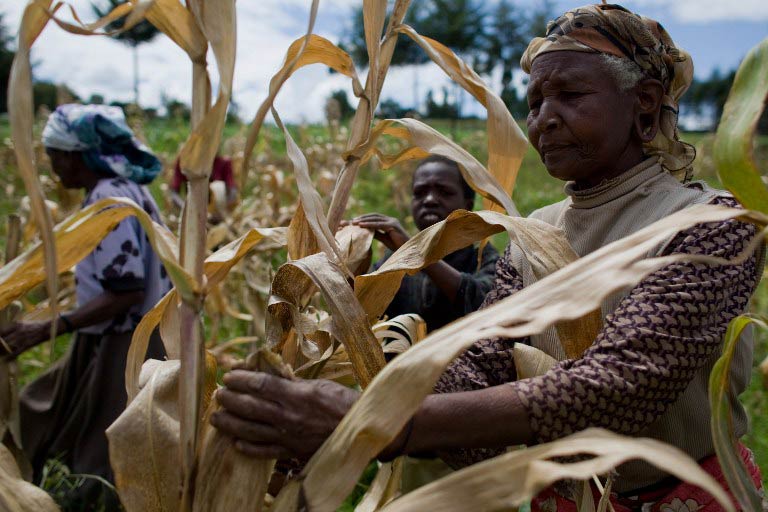
It’s mid-morning and the sun is blazing. It is so hot that germinating seeds struggle to grow.
In Moi Ndabi, about 44km south of Kenya’s Lake Naivasha in Nakuru County, the vegetation dotted sparingly across the village has turned yellow.
More than 100 people have lined up at the Moi Ndabi borehole to wait their turn to fetch water sold at five Kenyan shillings ($0.05) per 20-litre jerry can.
But about 12km away from the water point in this region of the Rift Valley two greenhouses of different sizes stand adjacent to the homestead of Zainabu Malicha. By the end of March, she hopes to have pocketed at least 1.2m shillings ($13 100) from the sale of the tomatoes she grows there.
For the widow who is now solely responsible for the care of her five children, this venture into agribusiness has transformed her life, which for much of the last two decades has been dominated by hunger, poverty and malnutrition.
“Living in this semi-arid area [used to mean] no viable farming activity,” she says.
Malicha’s business venture relies on a simple water-harvesting technology: a water pan. Constructing the pan – a circular container 20m across – involves digging a dam and covering it with a dam liner. The pan then stores the runoff water during the heavy rains. Once full, it can provide enough water for Malicha for up to four months until the next rainy season.
“Before 2011, when the water pan was constructed, life was hard. Extremely hard. Maize would fail due to [the] scorching sun. Vegetables withered every so often. Going to sleep hungry was common,” Malicha says.
Having made 600 000 shillings ($6 500) from produce grown in the smaller greenhouse, Malicha used the proceeds to set up the bigger one. “I have so much joy now because I can comfortably feed my children with [a] balanced diet and meet the education expenses,” she says.
A few miles from her homestead, Florence Muthoni is also enjoying the fruits of the water reservoir.
Having access to a greenhouse has enabled her to grow watermelons, a crop she once attempted and failed to grow on her hectare (2.5 acres) of land.
“After two months, I harvest and make 135 000 shillings ($1 475). This is good enough to pay for my two sons on parallel programmes in local universities,” says the widow, who has lived in the area since 1992.
On a separate half-hectare of land she has also grown vegetables, some bananas and sugarcane, made possible through using water pans.
“I plan to buy a plot and then rear two Friesian cows. This could raise my profits, and when I finally become old, my children would take over,” she says.
Having the water pan, Muthoni says, has emancipated her from hunger and “opened up her mind to hope for great things” not just for herself but for other women in the village.
Muthoni and Malicha now lead a group of 286 women who form the Chemi Chemi ya Tumaini Jangwani Women Group (Springs of Hope in the Desert Women Group) as chair and secretary respectively.
Even though the water pans led to solutions to the problems of food scarcity and related health issues, their construction was possible only with the assistance of an NGO.
Muthoni says the NGO spent 20m shillings ($200 000) on setting up 50 water pans in the area for the women to irrigate their farms. The amount includes the 560 000 shillings used for their smaller greenhouses.
“We hear the government has loans for women, but how to get them is what we do not know. If it wasn’t for the NGO, we could still be suffering in hunger,” says Muthoni. “We need people to reach out to us in the villages and give us a sense of direction, just like non-governmental organisations do.”
The Kenya Institute of Economic Affairs report (2014), Public Spending in Agriculture in Kenya: Is It Beneficial to Small Scale Women Farmers? (pdf), notes the increasing importance of NGOs as a source of credit to farmers in the country. Although women are the backbone of the agricultural sector, the report showed that many of them had not benefited from agricultural credit.
Worryingly, the lack of gender-disaggregated information on credit beneficiaries continues to hamper balanced distribution of available resources, it says. Despite the creation of government funds specifically for women, only a few have benefited from them. Women make up more than half of Kenya’s population of 44 million.
Through community groups, women can access money from the Women Enterprise Fund , established in 2007, and the Uwezo Fund , launched in 2013. So far 707 435 women have received funding from the WEF while 274 857 have been trained in business management skills, according to statistics from the Ministry of Devolution and Planning.
